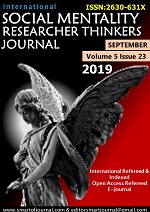Author :
Abstract
Bilgi çağının insan hayatına girmesiyle birlikte farkındalık düzeyinde olumlu gelişmeler yaşanmaktadır. Turizm tercihlerinde de bu gelişim hissedilmekte ve insanlar klasik turizm hareketlerinin dışında yer alan kültürel seyahatlere önem vermektedirler. Kültürel seyahatlerin oluşumunda rol oynayanların başında kültürel miras zenginlikleri gelmektedir. Bu zenginlikler, turistik bölgenin çekicilik düzeyini arttırmakta ve talep oranlarında yükseliş sağlamaktadır. Somut ve soyut olan kültürel miras değerlerinde dini inanç merkezleri önemli bir yer tutmaktadır. Şanlıurfa, tarih boyunca önemli inanç merkezlerinden biri olmuştur. Bu kapsamda araştırmanın amacı, Kültürel miras ve dini yapılarla ilgili literatüre yer vererek kültürel zenginlik olan ve Şanlıurfa ilinde yer alan dini ibadet yapılarını ortaya koymak ve kavramsal bir bakış açısı ile değerlendirmektir. Şanlıurfa’nın kültürel miras zenginlikleri içerisinde yer alan dini ibadet alanları ile ilgili bilgi eksikliğinin belirli ölçülerde giderilmesi hedeflenmektedir. Elde edilecek sonuçların ilgili literatüre katkı sağlayacağı düşünülmektedir. Ayrıca dini değerlerin kültürel miras bakımından önemli bir potansiyel taşıdığına vurgu yapılarak Şanlıurfa’nın turizm gelişiminde rol oynayan paydaşlara öneriler yer almaktadır.
Keywords
Abstract
As information age enters into human life, positive developments are being experienced at the level of awareness. This development is also felt in tourism preferences and people attach importance to cultural trips that are outside the classical tourism movements. Cultural heritage is at the forefront of those who play a role in the formation of cultural travels. These riches increase the attractiveness of the tourist zone and increase demand rates. Religious centers of faith have an important place in the concrete and abstract values of cultural heritage. Sanliurfa has been one of the important faith centers throughout history. The aim of the research is to reveal the religious worship structures in the province of Sanliurfa, which has cultural richness by giving a literature about cultural heritage and religious structures and to evaluate them with a conceptual point of view. It is aimed to eliminate the lack of information about religious worship places in Şanlıurfa's cultural heritage riches with certain measures. It is thought that the results obtained will contribute to the related literature. In addition, it emphasizes that religious values have important potential for cultural heritage and suggests to stakeholders who play a role in Şanlıurfa's tourism development.
Keywords
- Chen, C. (2002). The religious varieties of ethnic presence: A comparison between a Taiwanese
- Chen, C. (2002). The religious varieties of ethnic presence: A comparison between a Taiwaneseimmigrant Buddhist temple and an evangelical Christian church. Sociology of Religion, 63(2), 215- 238.
- Collins, A. (2013). http://www.andrewcollins.com/page/articles/magicians.htmErişişm Tarihi: 02.06.2019
- Cros, H. (2001). A new model to assist in planning for sustainable cultural heritage tourism. International journal of tourism research, 3(2), 165-170.
- Dendrinos, D. S. (2016). Gobekli Tepe: a 6 th millennium BC monument. University of Kansas, Lawrence, Kansas, USA. In residence at Ormond Beach, Florida. Phd. Thesis.
- Güneş, H. (2014). Cezîre bölgesinde yaşadığına inanılan peygamberler. Şırnak Üniversitesi İlahiyat Fakültesi Dergisi, 5(10), 27-50.
- Harrıngton J. ve Ottenbacher C. (2010), CulinaryTourism- A Case Study of theGastronomicCapital, Journal of CulinaryScience&Technology
- Herevî, Ebü’l-Hasen Ali b. Ebî Bekr es-Sâih (611/1215), el-İşârât ila Ma’rifeti’z-Ziyârât, thk. Ali Ömer, Mektebetü’s-Sekâfeti’d-Dîniyye, Kahire 2002.
- Jang, S. S., & Wu, C. M. E. (2006). Seniors’ travel motivation and the influential factors: An examination of Taiwanese seniors. Tourism management, 27(2), 306-316.
- Karamustafa, K., Birdir, K., & Kiliçhan, R. (2016). Gastronomik Akimlar Çerçevesinde GidaTüketim Ölçegi1. Tüketici ve Tüketim Araştırmaları Dergisi= Journal of Consumer andConsumptionResearch, 8(2), 29.
- Li, M.,&Cai, L. A. (2012). Theeffects of personalvalues on travelmotivationandbehavioralintention. Journal of Travel Research, 51(4), 473-487.
- Lumsdon, L. (2000). Transport and tourism: cycle tourism–a model for sustainable development?. Journal of Sustainable Tourism, 8(5), 361-377.
- Magli, G. (2016). Sirius and the project of the megalithic enclosures at Gobekli Tepe. Nexus Network Journal, 18(2), 337-346.
- Raj, R., & Griffin, K. A. (Eds.). (2015). Religious tourism and pilgrimage management: An international perspective. Cabi.
- Sargın, S. (2006). Yalvaç’ta İnanç Turizmi. Fırat Üniversitesi Sosyal Bilimler Dergisi, 16(2), 1-18.
- Silberberg, T. (1995). Cultural tourism and business opportunities for museums and heritage sites. Tourism management, 16(5), 361-365.
- Simon C. W. (2004) Faith and tourism: planning tourism in relation to places of worship, Tourism and Hospitality Planning & Development, 1:2, 173-186
- Tapur, T. (2009). Konya İlinde Kültür ve İnanç Turizmi. Uluslararası Sosyal Araştırmalar Dergisi , 2 (9), 473‐492.
- Taşpınar, O. (2018). A New ConceptGeneratedbyCommoditizing Animals: Egologicaltourism. Advances in HospitalityandTourismResearch (AHTR), 6(1), 111-118.
- Turhan, M. (1994). Kültür Değişmeleri (Sosyal Psikoloji Bakımından Bir Teknik), İstanbul: Marmara Üniversitesi İlahiyat Fakültesi Vakfı Yayınları
- Özgen, N. (2012). Siirt’in İnanç Turizmi Mekânları: Ziyaret (Veysel Karani) ve Tillo (Aydınlar) Örnekleri. Doğu Coğrafya Dergisi, 17(27), 251-272.
- Özmenli, M., & İlişkisi, T. M. (2014). Turkish Studies-International Periodical For The Languages, Literature and History of Turkish or Turkic. Volume, 9(10), 1281-1292.
- Vardia, S. (2008). Building science of indian temple architecture. School of Planning and Architecture, Bhopal. Phd Thesis. Portugal).
- Vijayanand, S. (2012). Socio-economic impacts in pilgrimage tourism. International Journal of Multidisciplinary Research, 2(1), 329-343.
- Woodhead, L. (2011). Five concepts of religion. International review of Sociology, 21(1), 121-143.
- Şanlıurfa Belediyesi, 2019 https://www.sanliurfa.bel.tr/icerik/68/6/inanc-turizmi Erişim Tarihi: 20.06.2019
- Şanlıurfa Valiliği, 2019 http://www.sanliurfa.gov.tr/kiliseler Erişim Tarihi: 17.06.2019
- TMO, http://www.tmo.gov.tr/Upload/Images/SubeHarita/Kultur/sanliurfa.pdf Erişim Tarihi: 10.06.2019
- TÜRSAB, http://www.tursab.org.tr/dosya/12192/tursabinancturizmi_12192_5616832.pdf Erişim Tarihi: 19.06.2019
- UNWTO, http://marketintelligence.unwto.org/content/unwto-world-tourism-barometer Erişim Tarihi: 04.06.2019
